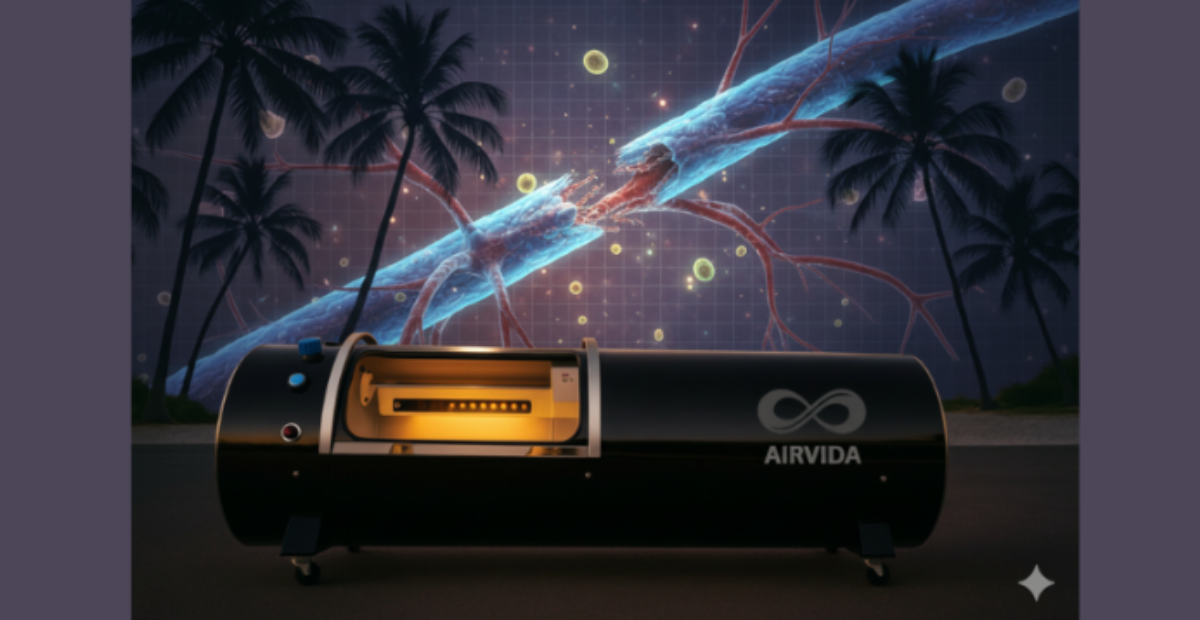Hyperbaric chamber treatment for neuropathy is an innovative therapy that supports nerve repair and pain relief using concentrated oxygen. By increasing oxygen levels in the blood, this therapy may help improve circulation, reduce inflammation, and promote nerve regeneration for people with neuropathy across the U.S.
If you’re wondering whether this therapy could help manage symptoms like numbness, tingling, or burning pain, this guide offers a clear explanation of how it works, what benefits it may provide, and how to determine whether hyperbaric chamber treatment for neuropathy is the right supportive option for your recovery.
What Is Hyperbaric Chamber Treatment?
A hyperbaric chamber treatment involves breathing 100% oxygen in a pressurized environment. This process allows your blood to carry higher levels of oxygen, which helps tissues heal faster and enhances nerve recovery.
The therapy takes place inside a sealed chamber, where air pressure is increased to about 1.5–3 times normal levels. The increased oxygen reaches areas with limited blood flow, which can be particularly beneficial for those suffering from peripheral neuropathy.

Why Oxygen Therapy Matters for Nerve Health
Nerves require a steady oxygen supply to function and regenerate properly. In people with neuropathy, reduced blood circulation can slow down repair and worsen symptoms. Hyperbaric oxygen therapy (HBOT) helps counter this by delivering oxygen deep into tissues where it’s needed most.
When nerve cells receive more oxygen, it enhances mitochondrial activity, which boosts energy production at the cellular level. This process supports the repair of damaged nerve pathways, promotes improved communication between brain cells, and helps restore normal neurological function crucial for recovery and cognitive improvement after stroke or brain injury.
How Hyperbaric Chamber Treatment for Neuropathy Works
The science behind hyperbaric oxygen therapy focuses on promoting cellular healing. During treatment, oxygen dissolves into plasma rather than relying only on red blood cells, enabling higher oxygen delivery throughout the body.
Step-by-Step Overview
|
Step |
Process |
What Happens |
|
1 |
Session Setup |
You lie in a comfortable hyperbaric chamber while pressure gradually increases. |
|
2 |
Oxygen Intake |
You breathe 100% oxygen for about 60–90 minutes. |
|
3 |
Cellular Response |
Oxygen boosts cellular repair, reduces inflammation, and supports nerve healing. |
|
4 |
Post-Session Effects |
Patients often feel relaxed, and with repeated sessions, may notice symptom improvement. |
Key Biological Effects
-
Improved Circulation: Encourages the growth of new blood vessels (angiogenesis), enhancing nutrient delivery to nerves.
-
Reduced Inflammation: High oxygen levels decrease swelling and oxidative stress.
-
Accelerated Nerve Repair: Stimulates stem cell activity and regeneration of damaged nerve fibers.

Why People Use Hyperbaric Therapy for Neuropathy
Neuropathy can result from diabetes, injury, infections, or autoimmune conditions. Whatever the cause, the symptoms of pain, tingling, or numbness can significantly affect daily life. HBOT offers a supportive option alongside conventional treatments.
Benefits Backed by Research
|
Benefit |
Description |
|
Pain Relief |
Increased oxygen can calm overactive nerves and reduce burning sensations. |
|
Enhanced Healing |
Supports regeneration of nerve endings and tissue repair. |
|
Better Circulation |
Promotes blood flow in extremities, helping those with diabetic or peripheral neuropathy. |
|
Reduced Swelling |
Oxygen reduces inflammation in affected nerves. |
Many users report noticeable improvements in sensation, comfort, and overall nerve responsiveness after several HBOT sessions. However, results may vary depending on the type and severity of neuropathy, individual health conditions, and session frequency, so consistent therapy and proper medical guidance are key to achieving the best possible outcomes.
Choosing the Right Hyperbaric Chamber
If you’re considering home-based or clinical HBOT, choosing the right chamber type is essential for both comfort and effectiveness. The right setup ensures consistent oxygen delivery, proper pressure control, and user safety, allowing you to maximize the therapy’s benefits while meeting your personal recovery goals and lifestyle preferences.
-
Explore our large hyperbaric chamber collection for professional-grade options with spacious designs ideal for frequent users.
-
Find affordable hyperbaric chamber options suitable for personal or at-home therapy needs.
Each model provides safety certifications and design features that support long-term, effective oxygen therapy. From durable construction and easy-to-use controls to precise pressure regulation systems, these features ensure every session is safe, consistent, and optimized for healing, whether you’re using the chamber at home or in a professional clinic.

How Often Should You Use HBOT for Neuropathy?
The frequency depends on your condition and treatment goals. Typically, practitioners recommend 20–40 sessions, with each lasting 60 to 90 minutes. Some patients notice improvements after the first few sessions, while others experience gradual relief over time.
Most clinics carefully monitor your progress throughout the therapy process and make adjustments to the treatment schedule based on your body’s individual response. This personalized approach ensures that each session of hyperbaric chamber treatment for neuropathy remains safe, effective, and aligned with your specific healing needs and comfort level.
Possible Side Effects and Safety Tips
HBOT is generally safe when done under medical supervision, but it’s important to follow recommended guidelines. Mild effects like temporary ear pressure or light fatigue can occur. Staying hydrated and equalizing ear pressure during treatment can help minimize discomfort.
Avoid using oily products or perfumes before sessions, as they can affect air purity in the chamber. Always discuss your health history with your provider before starting HBOT, especially if you have respiratory or heart conditions.
Comparing Hyperbaric Oxygen to Other Neuropathy Treatments
While traditional treatments like medications and physical therapy primarily focus on managing symptoms or reducing discomfort, hyperbaric oxygen therapy (HBOT) takes a different approach by promoting the body’s own healing mechanisms. It works to enhance oxygen flow, cellular repair, and overall tissue regeneration. Here’s a quick comparison between the two approaches:
|
Treatment Type |
Primary Goal |
Key Advantage |
|
Medication |
Pain management |
Quick relief but temporary results |
|
Physical Therapy |
Muscle strength & balance |
Improves movement and reduces stiffness |
|
Hyperbaric Oxygen Therapy |
Cellular healing & regeneration |
Addresses root causes through oxygenation |
For many patients, combining HBOT with physical therapy and lifestyle changes can yield better long-term outcomes. This integrated approach helps strengthen circulation, restore nerve health, and improve overall well-being. Consistency and professional guidance are key to maximizing the benefits of each session and supporting gradual, sustainable recovery progress.
Related Reads
-
Learn how red light therapy for neuropathy compares to oxygen therapy for nerve healing.
-
Discover how hyperbaric chamber therapy supports multiple sclerosis and other chronic conditions.
Final Thoughts: Hyperbaric Chamber Treatment for Neuropathy
In the U.S., more people are turning to hyperbaric chamber treatment for neuropathy as an alternative or complementary therapy. It offers non-invasive support for pain management, improved circulation, and nerve regeneration. While not a cure, consistent HBOT sessions can enhance quality of life and reduce neuropathy-related discomfort.
By understanding how this therapy works and following proper medical guidance, you can make informed, confident decisions about including it in your overall wellness plan. This ensures you get the most out of every session while maintaining safety, balance, and alignment with your doctor’s personalized recovery or health goals.
Frequently Asked Questions
Can hyperbaric oxygen help neuropathy?
Yes. Hyperbaric oxygen therapy increases oxygen concentration in the blood, which promotes nerve repair and reduces inflammation. Many patients report better circulation, reduced pain, and restored sensation after consistent treatments. It’s especially helpful for diabetic and peripheral neuropathy cases when supervised by professionals.
What is the most effective treatment for neuropathy?
There’s no single cure, but combining therapies often works best. Hyperbaric chamber treatment for neuropathy enhances oxygen delivery, while medications, physical therapy, and proper nutrition manage symptoms. The most effective approach is individualized and supervised by a healthcare provider.
What is the 30-minute treatment for neuropathy?
Some clinics offer shorter oxygen therapy sessions or light-based therapies lasting about 30 minutes. Hyperbaric sessions usually run longer (60–90 minutes) to achieve optimal oxygen saturation and healing benefits. Always confirm the duration and purpose with your clinic before starting any new regimen.
Can hyperbaric oxygen restore feeling in my feet if I have neuropathy?
Hyperbaric oxygen therapy may help restore sensation by improving oxygen flow and nerve regeneration in affected areas. While results vary, many users report gradual improvements in numbness and tingling after several sessions. Consistency and proper supervision are key to achieving long-term progress.




